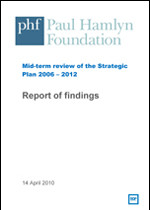7 Implications for Paul Hamlyn foundation
This review finds that Paul Hamlyn Foundation is still at the early stages of learning how to be a strategic philanthropist. The first four years of the Plan have rightly focused on gearing up to pursue the first three core aims of the Strategy. Major internal changes have taken place. A great deal of activity is now underway, with a great deal more in the pipeline. There is a potentially powerful distinctive model of strategic philanthropy in the making.
There is no suggestion from the findings of the review that the Foundation should change its direction of travel. Indeed, PHF’s peers and collaborators are keen for the organisation to ‘carry on and hone it’. The focus on its three core strategic aims should continue. But the findings of this review suggest that much greater attention needs to be given in the next phase of the Strategic Plan to the activities which support the successful pursuit of these aims.
There are four specific issues to be dealt with:
-
Demonstrating and reporting on outcomes and impact
In keeping with its new strategic approach, the Foundation would benefit from being be more explicit about of the impact it is seeking to achieve – particularly at the more strategic level of policy and practice. This will require investment in assembling that evidence in an integrated way so that it has a clearer narrative about its successes and failures. This is both an internal and external process (see below).
The proposed new impact reporting framework, which builds on the outcomes-based Open Grants process, is a good starting point. It can be used to assess grants, design Special Initiatives, improve reporting – and as an important reference point for future research and improvement activity. It might also be used as the basis for developing value for money indicators.
The framework will help to address the questions about longer-term impact of which the Foundation will want to know for itself and to tell the world about at the end in 2013 and beyond.
-
Research, knowledge and improvement
The Foundation can make a great deal more of the knowledge building up within and across its programmes to advance its aims. Thinking within the organisation has moved on from research per se, to a broader understanding of how knowledge is generated, captured and spread. Effective models for this type of knowledge advancement already exist within several Special Initiatives. The process of internal and external consultation behind this review itself is a good example of knowledge sharing.
The Foundation’s knowledge about social change is particularly valuable in context of the larger than expected economic and political changes which have taken place in the lifetime of the Plan. One advisor suggests that Paul Hamlyn Foundation, along with other Foundations who work in the field of educational reform, should be publicly re-enforcing the lessons learnt from the work of the past decade to future political administrations.
-
Capacity building
The Foundation should consider the current internal resources – including the knowledge and skills, required to work more effectively in this area – in particular around Open Grants. This would include a re-evaluation of how officers work within the project cycle, with more engagement during the course and at the end of a project. Again, Special Initiatives provides models for structured capacity building. The Foundation can also build on its growing ‘Beyond Grants’ activity.
-
Communications
All of the above activities have an important external as well as internal dimension. The Foundation will require an ever-stronger public narrative about its impact as the Strategic Plan moves to its conclusion. The learning and improvement loop includes grantees, partners and stakeholders, as well as the broader sectors in which the Foundation works. Persuading others to adopt agendas, invest in organisations and fund programmes is a vital part of capacity building. The Communication Strategy points the way forward. There is plenty of scope to make even more use of communication tools such as the website and the Yearbook.
